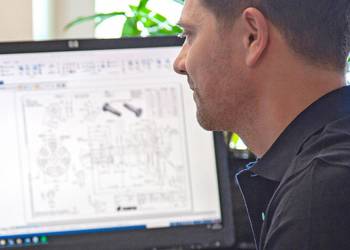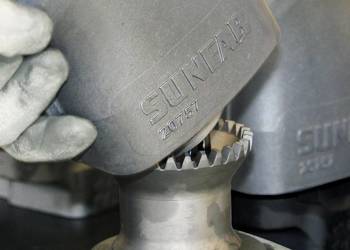Calculatrices hydraulique
IMPORTANT: The information provided has been carefully checked and is given in good faith, but users should take the necessary steps to ensure the accuracy and relevance to their specific requirements. Sunfab Hydraulics AB, do not accept any liability for injury, damage or unsatisfactory operation resulting from the construction or use of any machines designed using this information.
Units
Unit Converter. Enter device value.
=
=
=
=
=
=
=
Please note! When we suggest standard values, this gives you a very close approximation that is good enough for general use. You can of course also enter the actual values instead of the standard values.
Measurements and units used
|
Torque
|
T | Nm |
| Differential pressure * | Δp | Bar |
| Speed | n | rpm |
| Geometr. displacement volume per rotation | Vg | cm³/rpm |
* Δp diffrence between port 1 and port 2 on hydraulic motors.
| Power | P | kW |
| Flow | qv | L/min |
| Mechanical hydraulic efficiency ** | ηmh | 0.9 - 0.95 |
| Total efficiency | ηt | 0.8 - 0.9 |
** NOTE! At pressures below 100-150 bar, hydraulic mechanical efficiency curves should be used for hydraulic motors.
Hydraulic pumps
1. What displacement do we get?
If you know flow (l/min) and speed (rpm)
Vg = geometric displacement volume cm³/rpm
2. What displacement do we get?
If you know torque (Nm) and system pressure (bar)
Vg = geometric displacement volume cm³/rpm
3. What flow do we get?
If you know displacement (cm³/rpm) and speed (rpm)
qv = Flow in l/min
4. What speed do we get?
If you know flow (l/min) and displacement (cm³/rpm)
n = Speed in rpm
5. What torque do we get?
If you know displacement (cm³/rpm) and system pressure (bar)
T = Torque in Nm
6. What power do we get?
If you know flow (l/min) and system pressure (bar)
P = Power in kW
Hydraulic motors
1. What flow do we get?
If you know displacement (cm³/rpm) and speed (rpm)
qv = Flow in l/min
2. What flow do we get?
If you know power (kW) and differential pressure (bar)
qv = Flow in l/min
3. What displacement do we get?
If you know flow (l/min) and displacement (cm³/rpm)
Vg = geometric displacment volume cm³/rpm
4. What displacement do we get?
If you know power (kW) and differential pressure (bar)
Vg = geometric displacment volume cm³/U
5. What rpm do we get?
If you know flow (l/min) and displacement (cm³/rpm)
n = Speed in rpm
6. What rpm do we get?
If you know power (kW) and torque (Nm)
n = Speed in rpm
7. What torque do we get?
If you know displacement (cm³/rpm) and differential pressure (bar)
T = Torque in Nm
8. What torque do we get?
If you know power (kW) and speed (rpm)
T = Torque in Nm
9. What differential pressure do we get?
If you know torque (Nm) and displacement (cm³/rpm)
Δp = Differential pressure in bar
10. What differential pressure do we get?
If you know power (kW) and flow (l/min)
Δp = Differential pressure in bar
11. What power do we get?
If you know torque (Nm) and speed (rpm)
P = Power in kW
12. What power do we get?
If you know differential pressure (bar) and flow (l/min)
P = Power in kW



